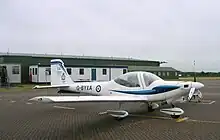Air Experience Flight
An Air Experience Flight (AEF) is a training unit of the Royal Air Force Volunteer Reserve (Training Branch) whose main purpose is to give introductory flying experience to cadets from the Air Training Corps and the Combined Cadet Force. As of 2019, thirteen AEFs are active.
History
The AEFs, numbered from 1 to 13, were formed across the United Kingdom in 1958, all but two forming on the same day, 8 September.[1] All were equipped with the de Havilland Canada DHC-1 Chipmunk T.10 trainer. An exception was No. 5 AEF, which also operated a single Beagle Husky (XW635) from 1969 to 1989.[2][3]
In the mid-1990s they were merged with co-located University Air Squadrons (UASs), the Chipmunks being replaced by the existing UAS Scottish Aviation Bulldog T.1s. No. 13 AEF at RAF Aldergrove was disbanded in 1996.[1] In 1999, the Grob Tutor T.1 began to replace the Bulldog.[1]
On 10 March 2016, Julian Brazier, Parliamentary Under-Secretary (Ministry of Defence), announced the return of 13 AEF and a new 14 AEF.[4]
Role and operations
The Royal Air Force (RAF) Air Experience Flights (AEF)[5] are co-located with University Air Squadron (UAS) units; the co-located AEF and UAS units pool resources and share aircraft. Air Experience Flights provide basic flying experience, and aerobatics to eligible members of Royal Air Force Air Cadets (RAFAC), otherwise known as the Air Training Corps (ATC), along with the RAF section of the Combined Cadet Force (CCF-RAF), and other air-minded youth groups such as Air Scouts and the Girls Venture Corps Air Cadets (GVC-AC).
When two separate AEFs are co-located at the same airfield, such as No. 9 Air Experience Flight ( 9AEF) and No. 11 Air Experience Flight (11 AEF) at RAF Leeming, the two individual AEFs share the same fleet of aircraft. Just like the University Air Squadrons, all Air Experience Flights are currently commanded by No. 6 Flying Training School RAF (6 FTS).[5][6]
Current flights
- No. 1 Air Experience Flight RAF – MoD St Athan
- No. 2 Air Experience Flight RAF – MoD Boscombe Down
- No. 3 Air Experience Flight RAF – Colerne Airfield
- No. 4 Air Experience Flight RAF – Glasgow Airport
- No. 5 Air Experience Flight RAF – RAF Wittering
- No. 6 Air Experience Flight RAF – RAF Benson
- No. 7 Air Experience Flight RAF – RAF Cranwell
- No. 8 Air Experience Flight RAF – RAF Cosford
- No. 9 Air Experience Flight RAF – RAF Leeming
- No. 10 Air Experience Flight RAF – RAF Woodvale
- No. 11 Air Experience Flight RAF – RAF Leeming
- No. 12 Air Experience Flight RAF – Leuchars Station
- No. 13 Air Experience Flight RAF – JHC FS Aldergrove
- No. 14 Air Experience Flight RAF – TBA
Aircraft
| Aircraft | In fleet | Order | Notes |
|---|---|---|---|
| Grob Tutor T.1 | 91[7] | 0 | RAF "Tutor" designation with flight stick instead of yoke. |
Previously operated:
 Chipmunk T.10 in RAF colours
Chipmunk T.10 in RAF colours Bulldog T.1 in RAF colours
Bulldog T.1 in RAF colours 10 AEF Grob Tutor and hangar at RAF Woodvale
10 AEF Grob Tutor and hangar at RAF Woodvale No. 8 Air Experience Flight Grob Tutor in flight
No. 8 Air Experience Flight Grob Tutor in flight
References
- "RAFVR Units". Air of Authority. 25 April 2009. Archived from the original on 8 May 2009. Retrieved 7 September 2010.
- "Beagle D-5/180 Husky aircraft". airliners.net. Retrieved 7 September 2010.
- "UK Serials (XW)". ukserials.com. UK Serials Resource Centre. Retrieved 7 September 2010.
- "Air Cadet Aviation Relaunch:Written statement – HCWS605". MoD. Retrieved 10 March 2016.
- "Royal Air Force news – 6 Flying Training School". www.RAF.MoD.uk. Royal Air Force. 2015. Archived from the original on 12 October 2015. Retrieved 22 June 2022.
- "RAF College Cranwell – No 6 Flying Training School". www.RAF.MoD.uk. RAF Cranwell, Lincolnshire, England: Royal Air Force. Retrieved 23 September 2021.
- "UK Armed Forces Equipment and Formations 2020". Gov.uk. Ministry of Defence. 10 September 2020. Archived from the original on 31 October 2020. Retrieved 10 December 2020.